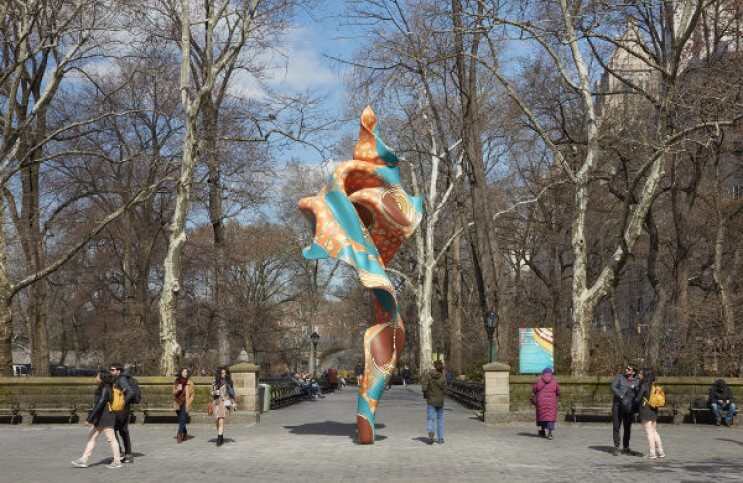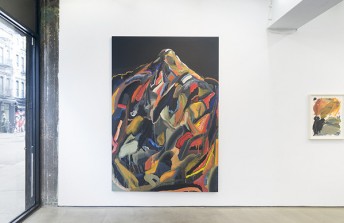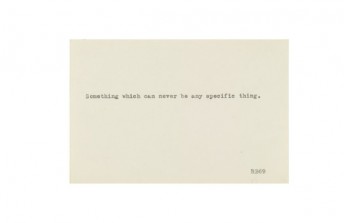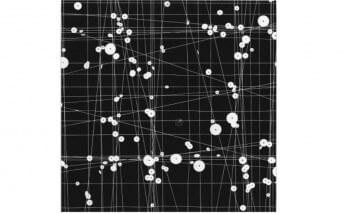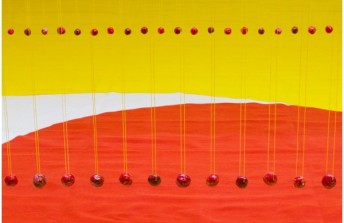Yinka Shonibare - A Post-Colonial Hybrid
Mar 16, 2018
A new sculpture by Yinka Shonibare, MBE was recently installed at the southeast entryway to Central Park, in the center of Doris C. Freedman Plaza. The swirling, energetic, colorful, fiberglass form is titled Wind Sculpture (SG) I. The SG refers to the fact that this is the second generation of wind sculptures Shonibare has made. The first generation was a bit smaller and less complex. This sculpture was designed using 3D printed models, which allowed for unprecedented complexity to be integrated into the form. Wind Sculpture (SG) I features a hand-stenciled pattern of orange, red and turquoise abstract designs. The colors were chosen by the artist because they relate to his memories of going to the beach while growing up in Lagos, Nigeria. The patterns are a continuation of an aesthetic theme Shonibare has been pursuing for much of his career. They are inspired by batik fabrics—a type of colorful, vibrant, intricately designed cloth that has long been popular in Africa. If asked, most people today would likely say that batik fabric must be distinctively African, since it has become such an iconic element of African fashion culture. However, in reality, batik fabric is almost all made in the Netherlands. It was originally invented by the Dutch, who intended to sell it in their Indonesian colonies. Its production method is based on Indonesian wax dying techniques. When Dutch batik fabric was introduced in Indonesia in the 1800s, the colonists there rejected it, leading the Dutch to transport it for sale in their African colonies instead. There, it took off. Shonibare appropriates the visual language of batik fabric because he considers it a perfect expression of “a crossbred cultural background.” It represents the true, underlying complexity of the cultural and national identities that have come to define the post-colonial world.
Sails From a Bottle
Though it is essentially abstract, the form Shonibare developed for Wind Sculpture (SG) I is intended to evoke a sail. The theme of colonial ocean travel is essential to the rest of his oeuvre. One of his most famous public works was called Nelson's Ship in a Bottle. Installed in the heart of Trafalgar Square in London, it was a massive sculpture of a bottle that included within it a 1:30 scale replica of the HMS Victory, the flagship of Lord Nelson when he won for England the Battle of Trafalgar in 1805. The sails of the ship in that bottle were decorated with batik fabric patterns. Shonibare speculated when he made that piece that the British victory over France and Spain in that battle led directly to expanded British rule in Africa, which led indirectly to him being born in London in 1962, and to his family choosing to move to Nigeria when he was three. Colonialism led to the battle, which led to the sculpture, which references the battle, while alluding to the legacy of colonialism.
When it was installed in Trafalgar Square in 2010, Nelson's Ship in a Bottle was described as the first public work in the square to directly address the battle for which the location is known. But there was some debate over just how it was addressing the topic. The presentation of the ship as a monumental kind of toy invites an assessment of colonialism as a sort of large-scale game played by the powerful. The batik fabric prints on the sails demonstrate the far-reaching effects of cross-cultural influences. It was noted that Shonibare did not seem to be taking an overtly antagonistic approach to the discussion of the effects of colonialism. Instead, with this piece at least, he was simply starting a conversation about post-colonial reality, and the true roots of contemporary culture.
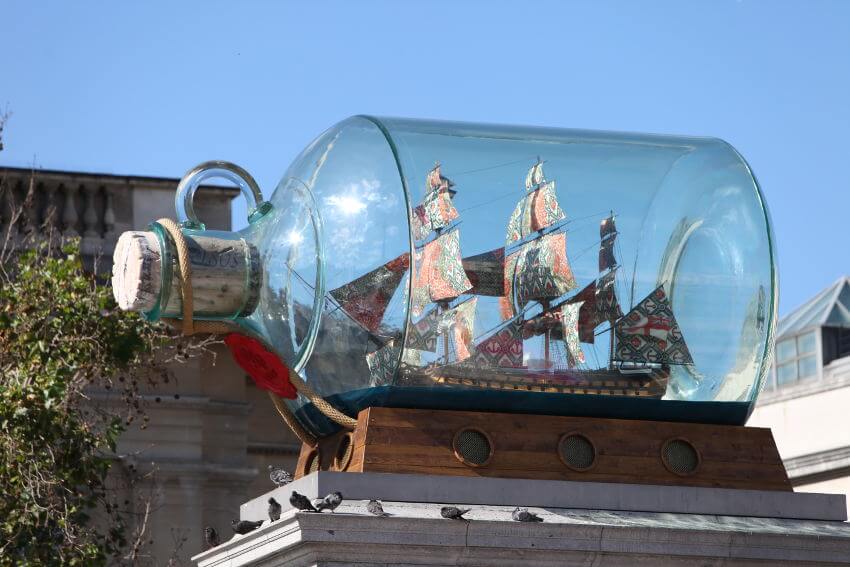
Yinka Shonibare - Nelson's Ship in a Bottle, 2010, photo via wikimedia.com
Inheriting the Wind
So effective was Nelson's Ship in a Bottle that for Shonibare the sails took on a life of their own, becoming the inspiration for his Wind Sculptures. In 2016, Wind Sculpture VII, his final first generation Wind Sculpture, was permanently installed on the National Mall in Washington, D.C., in front of the Smithsonian National Museum of African Art. That makes Wind Sculpture (SG) I the second Wind Sculpture to be installed in the United States. It comes at a time when it could be interpreted as prophetic. It addresses two key cultural-political issues: the international migrant crisis and the question over how to deal with culturally insensitive public monuments. If we were to be honest about the migrant crisis, we would have to admit that, biologically at least, all of humanity shares the same African origin. Our ancestors have migrated around the planet for nearly 2 million years. Colonialism was one step in a manifold process of cultural exchanges that have unfolded throughout the millennia.
Wind Sculpture (SG) I hints at the facts of our ancient migratory heritage, and suggests the absurdity of anyone claiming a “pure” national identity. It also hints at the illogical idea that anyone has the right to stop the movement of our human siblings from one place to another. It is a poetic statement about the unstoppable movement of people, ideas and products around the globe. Importantly, it is an invitation to see that movement not as something threatening, but as something that is complex and beautiful. In this time of political divisiveness, Wind Sculpture (SG) I also addresses the issue of public monuments in a constructive way. It does not call for the destruction of existing monuments. Rather, it presents us with a new monument—one which expresses the highest values of this generation. Those values are clear in the formal aspects of the work: it is open; it is organic, employing a mix of lyrical abstract lines and biomorphic forms; it is joyful, striving upward in conversation with the surrounding trees and skyscrapers; and it is inclusive, bearing a message that we are all connected in more ways than we know by the fabric of global human culture.
Featured image: Yinka Shonibare - Wind Sculpture (SG) I, 2018, Hand-painted fiberglass resin cast Courtesy Collection of Davidson College, NC, and James Cohan Gallery, NY Photo: Jason Wyche, © Yinka Shonibare
All images used for illustrative purposes only
By Phillip Barcio
